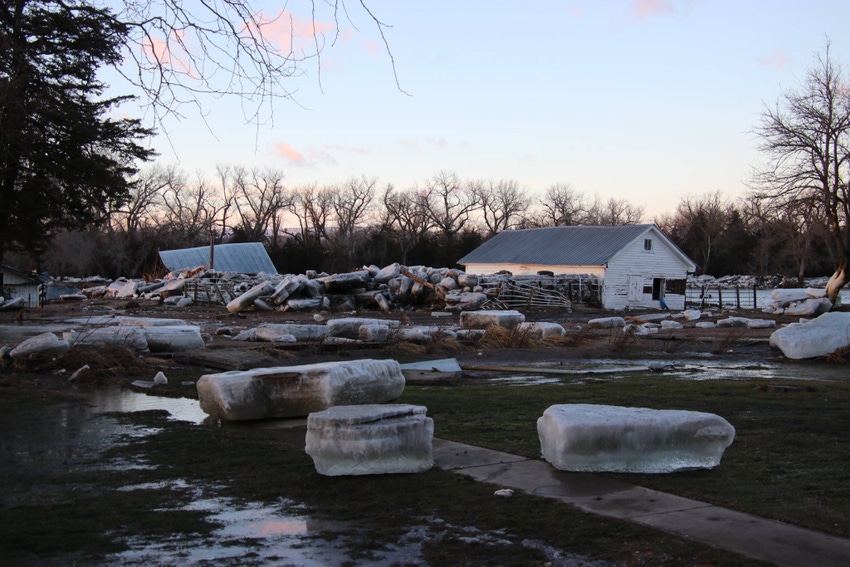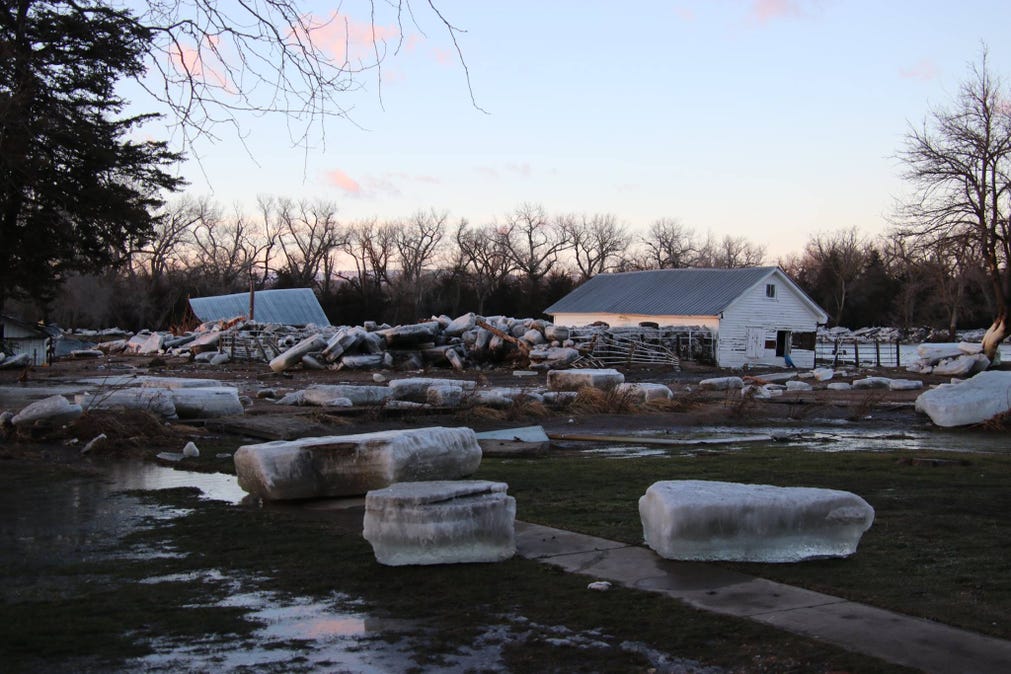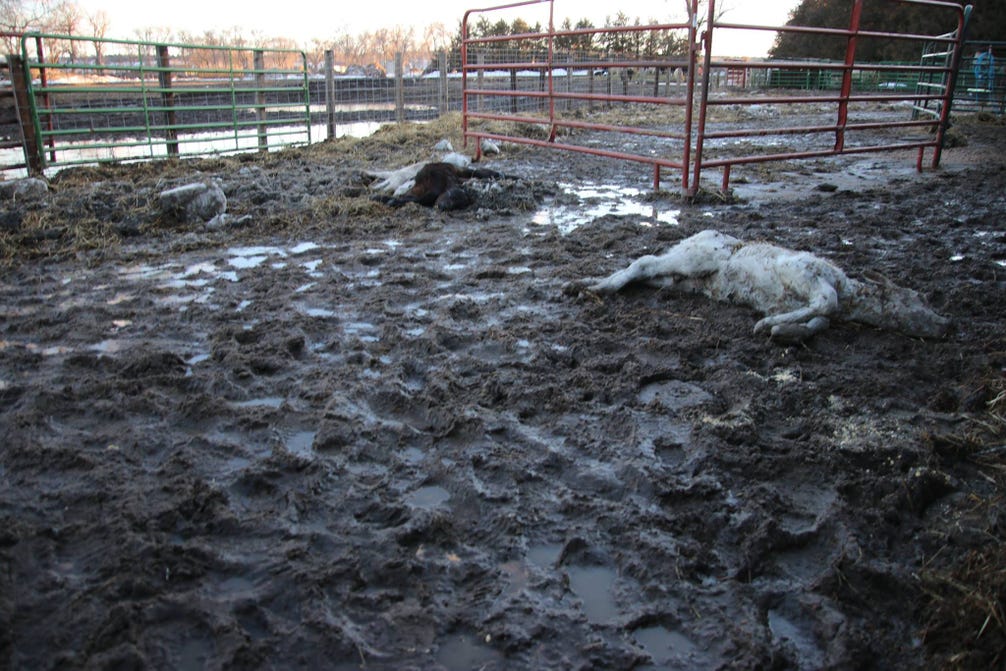Catastrophic Nebraska flooding hits ranchers hard, costs estimated at $1 billion
Nebraska family sees their 100-plus year-old farmstead pummeled by flood, livestock buried in ice.
March 20, 2019

By Troy Smith
It’s too soon to accurately tally the costs that farmers and ranchers in Nebraska and neighboring states will bear as a result of last week’s storm, dubbed a bomb cyclone. Offering his best guess, Nebraska Farm Bureau President Steve Nelson says costs could reach $1 billion.
In Nebraska, losses are expected to be greatest among producers in the eastern portion of the state, where flood waters and ice floes swept away cattle, feedstuffs and machinery, but also destroyed corrals, outbuildings and homes.
In western Nebraska, winter storm Ulmer delivered blizzard conditions. Snow was driven by sustained 40 miles-per-hour winds and gusts near 60 mph. Snowfall was heaviest in the northern Panhandle with a reported 17 inches in the Chadron area. According to Jack Arterburn, a University of Nebraska Extension Educator for that area, many ranchers were in the midst of calving season.
“The snow drifted badly, making it difficult to get to cattle and deliver feed and bedding,” says Arterburn. “The ranchers I’ve talked to reported calf losses in the single digits, but it’s likely that some operations lost more. Additional problems probably lie ahead if pneumonia breaks in calves stressed by the storm.”
Farther east, warmer air temperatures and rain caused snow to melt unusually rapidly that had accumulated during an already long, cold winter. Thick layers of ice on rivers and creeks broke up and starting moving downstream, jamming at many bridges. Behind these chokepoints, waters ran over their banks, across adjacent pastures and fields and onto roads.
“In this area, the initial river-out happened last Wednesday afternoon, but that wasn’t a huge problem,�” tells Anthony Ruzicka, whose family ranches along the Niobrara River near the northeastern Nebraska community of Verdigre. Their operation is roughly 40 miles downriver from the Spencer hydroelectric dam.

Photo by Lorie Kreycik Knigge | The Ruzicka farm was devasted as powerful water from an upstream dam rushed in. Destruction and these ice chunks were left behind.
“About 6:00 AM on Thursday [March 14}, we were notified that the dam was weakening and we had maybe two hours to evacuate. So we moved out what we could, starting with our better equipment, and we just barely made it,” says Ruzicka.
According to reports, the dam’s failure unleashed an 11-foot wall of water and ice which swept downstream. True to prediction, the torrent rushed through Ruzicka’s ranch headquarters about two hours later, mangling pipe corrals, outbuildings and the house built in 1906.
Fortunately, Ruzicka’s cows had been relocated early, to calving grounds away from headquarters. However, 15 calves died during the storm and, as a result of the flood, 12 breeding bulls now lie beneath jumble of ice some 20 feet deep.
“My great, great grandfather homesteaded here and we’ve been building up the place for five generations. Now it’s destroyed,” laments Ruzicka. “But there are a bunch of wonderful people trying to help us – neighbors helping look after our cattle, digging through the mud and ice and trying to help us salvage something.”

Photo by Lorie Kreycik Knigge | Despite desperately trying to move cattle, the Ruziska family lost 12 breeding bulls and 15 calves. A dam broke upstream because of ice jams.
With 74 towns and 65 of Nebraska’s 93 counties under state emergency declaration, there are a lot of cattle folk in need of help. Even those who have not experienced such severe losses of cattle and destruction of property must cope with the region’s damaged infrastructure—ruined bridges and damaged roads.
Pete McClymont, executive vice president of the Nebraska Cattlemen (association) says many producers now find the usual routes for transporting feedstuffs and other goods are impassable. He estimates the cattle industry’s increased cost of doing business at $1 million per day.
McClymont says he and other livestock industry representatives were invited, by Nebraska Governor Pete Ricketts and Director of Agriculture Steve Wellman, to participate in discussions with Federal Emergency Management Agency (FEMA) and state emergency management personnel. And, as this is written on March 19, Vice President Mike Pence is expected to tour some of Nebraska’s hardest-hit areas.
“We’re trying to hasten a federal emergency declaration and get assistance. But it requires a damage assessment with documentation, and that takes time,” says McClymont. “This isn’t like a tornado that hits and is gone, and you go add up the damages. We can’t yet see all the consequences of this storm. It could take two or three weeks, or longer.”
According to McClymont, the association has organized the Nebraska Cattlemen Disaster Relief Fund to accept tax deductible donations toward aiding Nebraska cattle producers affected by the recent weather event and its aftermath. Donations may be sent to Nebraska Cattlemen Disaster Relief Fund, 4611 Cattle Drive, Lincoln NE 68521. One hundred percent of funds received will be distributed to producers in need of assistance.
Donations of hay, feed, fencing materials and other supplies are being coordinated by the Nebraska Department of Agriculture. More information is available by calling 1-800-831-0550.
Smith is a rancher and freelance writer from Sargent, Neb.
You May Also Like



